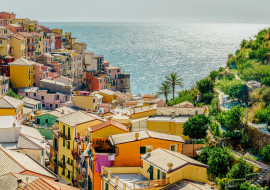How do Italians observe Ferragosto festivities?
How is the Italian holiday of Ferragosto celebrated? History and customs of the summer festival

Ferragosto is a significant festivity in Italy, with origins tracing back to Ancient Rome. On August 15th, those already on holiday can enjoy beach gatherings or take part in special seaside events. Meanwhile, those not yet on vacation can relish a well-deserved day off. But how exactly is Ferragosto observed in Italy? And what activities can you engage in to have a good time with your companions and relatives?
Why is it called Ferragosto? The historical background of the celebration
The term "Ferragosto" derives from the Latin phrase "Feriae Augusti", meaning "Augustus' rest." This pagan festivity was established by Emperor Augustus in 18 BC as a period of relaxation and revelry following the culmination of significant agricultural tasks.
It represented a genuine vacation season for the ancient Romans, during which all activities were halted. Festivities, equestrian competitions, and more took place. In the Christian era, Ferragosto coincided with the religious observance of the Assumption of Mary, celebrated on August 15th.
Intriguing aspects of Ferragosto
Due to being a celebration that involved the entire populace and being commemorated continuously since Roman times, Ferragosto became deeply ingrained in popular culture. Here are some fascinating details:
- The practice of venturing into nature dates back to the fascist era, during which organizations arranged excursions for their members using specialized trains.
- Have you ever questioned why it is customary to exchange well-wishes on Ferragosto? This practice also has ancient origins. In the period of the Papal State, laborers extended greetings to their employers in anticipation of gratuities.
- Since cinema integrated into popular culture, numerous movies have depicted Ferragosto in Italy, such as "Sorpasso" from 1962, Carlo Verdone's "Un sacco bello," and Nanni Moretti's "Caro Diario."
- Ferragosto is not solely celebrated in Italy. Across Europe, it is also observed in Catholic nations like France, Spain, Romania, Portugal, Greece, and various others.
What to engage in during Ferragosto?
Throughout this summer hiatus, a variety of activities can be pursued depending on the climate, time, and local customs. If you find yourself without vacation plans and seeking leisure options for the day, you might contemplate the following choices:
- Barbecue : This can be arranged either in the backyard of your residence or in parks where grilling is permitted. It's particularly delightful to barbecue near a lake or river.
- Trekking : This serves as an excellent means to detach from urban commotion, immerse yourself in nature, and explore scenic landscapes. Mountains, countryside, or the coastline are all suitable options.
- Fireworks : Numerous locales host firework displays, especially those with a strong Marian tradition or frequented by many tourists.
- Beach bonfires : Certain areas organize communal bonfires for enjoyment, such as in Valmalenco or other Italian regions. In some instances, self-made fires may be prohibited.
Local festivities and events during the Ferragosto weekend
Across Italy, Ferragosto is marked by an array of local events and festivities, varying from the northern to southern regions. Here are some notable occasions:
- Palio di Siena on August 16th, commemorating the Assumption.
- Saracen tournament in Sarteano featuring costume displays, traditional cuisine, and music.
- Vara in Messina, a vibrant festival parading through the entire city.
- Cavalcata of Assunta in Fermo, an age-old horse procession traversing the city streets.
From Piedmont to Sicily, each region boasts its distinct characteristics: village festivals, open-air concerts, sports competitions, and religious processions.
Traditional Ferragosto cuisine
Ferragosto signifies a time of merriment, uniting all of Italy around lavishly set tables with customary dishes and local delicacies. Every corner of the country showcases its unique culinary offerings. Nearly all dishes are light, given the warm weather prevailing during this period of the year.
In the northern regions
Northern Italy typically revels in a variety of dishes during Ferragosto. Alongside the classic barbecue, Trentino or Val d'Aosta may indulge in bacon dumplings. Lombardy presents a cold rendition of the traditional minestrone.
Coastal areas like Veneto and Liguria feature seafood dishes such as marinated sardines or caponata, relished even on the beach. Friuli Venezia Giulia and Emilia Romagna serve delectable stuffed pasta for lunch. Piedmont is renowned for its Margaritines from Stresa.
In central regions
The customs in central Italy vary slightly, yet the essence remains consistent. Tuscany offers roasted pigeon, a tradition dating back to the Middle Ages. Umbria prefers gnocchi with duck sauce, while in Lazio, particularly in Rome, chicken with peppers is a staple, ideal for sandwiches.
In the southern regions
Southern Italy, where many flock to the seaside or cooler locales, predominantly savors summer dishes. Campania prepares a pasta frittata from previous days' leftovers.
Puglia's signature dish is orecchiette with turnips, Calabria relishes stuffed pasta, Sardinia crafts culurgiones from potatoes, and Basilicata traditionally savors Lucanian lamb.







